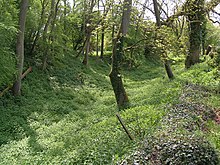John Giffard, 2nd Baron Giffard
John Giffard, 2nd Baron Giffard ( June 24, 1287 - May 6, 1322 ) was an English nobleman and rebel.
Youth and military career
John Giffard was the only son of John Giffard, 1st Baron Giffard and his third wife Margaret. When his father died in 1299, he became the heir of Brimpsfield and the extensive estates his father had acquired, including Rockhampton in Gloucestershire , Carreg Cennen Castle in South West Wales, Clifford Castle in Herefordshire and other estates in Wiltshire . Since he was still a minor, his possessions were placed under guardianship until he paid homage to the new King Edward II on May 8, 1308 . In 1309 he became administrator of Dryslwyn Castle in South West Wales, which he had to hand over to Thomas le Blund in 1312. From October 8, 1311 to May 15, 1321 he was a member of the English Parliament as Baron Giffard . On June 24, 1314, he was captured by the Scots at the Battle of Bannockburn . After his release, he participated from February 1316 in the suppression of the revolt of Llywelyn Bren in the Welsh Glamorgan . On April 20th he was appointed administrator of Glamorgan, the last lord of which had died at the Battle of Bannockburn. Giffard was less vengeful than Pain de Turberville , who had been the administrator before him. He pardoned numerous rebels before he had to surrender the administration of Glamorgan again on May 22, 1317, which finally fell to Hugh le Despenser , a nephew of his wife. In 1316 he was beaten to the Knight Banneret and was knight of the royal household until 1318.
Rebellion of the barons against despensers
Resistance arose among the barons to the increasing influence of Despenser on the king. Giffard hesitated for a long time to join the opposition barons, but he also turned down an offer from Despenser for a permanent alliance. When the opposition barons began an open rebellion, the so-called Despenser War , in the spring of 1321 to overthrow Despenser, Giffard finally joined them. In May and June he and other barons plundered Despenser’s holdings in south Wales. After Despenser was exiled on August 20, 1321, he was pardoned by parliament for this looting. From October 1321, however, Edward II took military action against the rebellious barons. After initially putting down the rebellion in south-east England, the king turned against the Marcher Lords in December. On December 7th he ordered the arrest of Giffard and on December 26th he ordered the demolition of Giffard's ancestral home, Brimpsfield Castle , which was destroyed in early 1322. On January 4, 1322 he confiscated Giffard's goods. Giffard then occupied Gloucester and blocked the king's passage over the Severn . The king went upriver to Worcester and on to Bridgnorth , but Giffard got ahead of him, destroyed the Bridgnorth bridge and ravaged the city. He was supported by Roger Mortimer of Chirk and his nephew Roger Mortimer of Wigmore . At Shrewsbury the king finally succeeded in crossing the Severn, where the Mortimers surrendered to him. The king then retired to Gloucester, where he lifted Despenser's exile. Giffard joined the Earl of Lancaster , one of the leaders of the rebellion, and initially participated in the siege of the royal castle of Tickhill in Yorkshire. On March 16, 1322, the rebellious barons were defeated by a royal army in the battle of Boroughbridge . The fugitive Giffard was captured the next day. A royal court did not hear his treason in London until April 28, in Gloucester. He was convicted of treason and hanged and quartered outside Gloucester .
Family and heirs
Giffard had married before November 6, 1311 Aveline, a daughter of Hugh de Courtenay († 1292), Lord of Okehampton and his wife Eleanor, a daughter of Hugh le Despenser, 1st Baron le Despenser . The marriage remained childless. His widow was allowed to keep King's Stanley estate in Gloucestershire for life, while Brimpsfield and most of the English estates fell to the elderly Despenser , his wife's brother. The Welsh estates fell to his son, the younger Despenser. After the fall of Edward II and the Despensers at the end of 1326, parliament reassigned Giffard's widow to her husband's confiscated property, but she died on April 27, 1327. After her death, several potential heirs claimed Giffard's property. After John de Caylewe should inherit the goods first, King Edward III spoke. 1329 the inheritance of John Maltraver , who is considered one of the murderers of Edward II. Caylewe sued this decision. In 1330 Caylewe was finally awarded the estates of John Giffard, while Maltravers was appointed heir to the estates of Margaret de Neville, the mother of John Giffard and widow of John Giffard, 1st Baron, who finally died in December 1338.
literature
- JN Langton: The Giffards of Brimpsfield . In: Transactions of the Bristol and Gloucestershire Archaeological Society, 1944 (65), pp. 105–128 ( online, pdf )
- Ruth F. Butler: The last of the Brimsfield Giffards and the Rising of 1321-2 . In: Transactions of the Bristol and Gloucestershire Archaeological Society, 1957 (76), pp. 75–97 ( Online, pdf )
| predecessor | Office | successor |
|---|---|---|
| John Giffard |
Baron Giffard 1299-1322 |
Title forfeited |
| personal data | |
|---|---|
| SURNAME | Giffard, John, 2nd Baron Giffard |
| BRIEF DESCRIPTION | Anglo-Norman nobleman and rebel |
| DATE OF BIRTH | June 24, 1287 |
| DATE OF DEATH | May 6, 1322 |
| Place of death | Gloucester |
